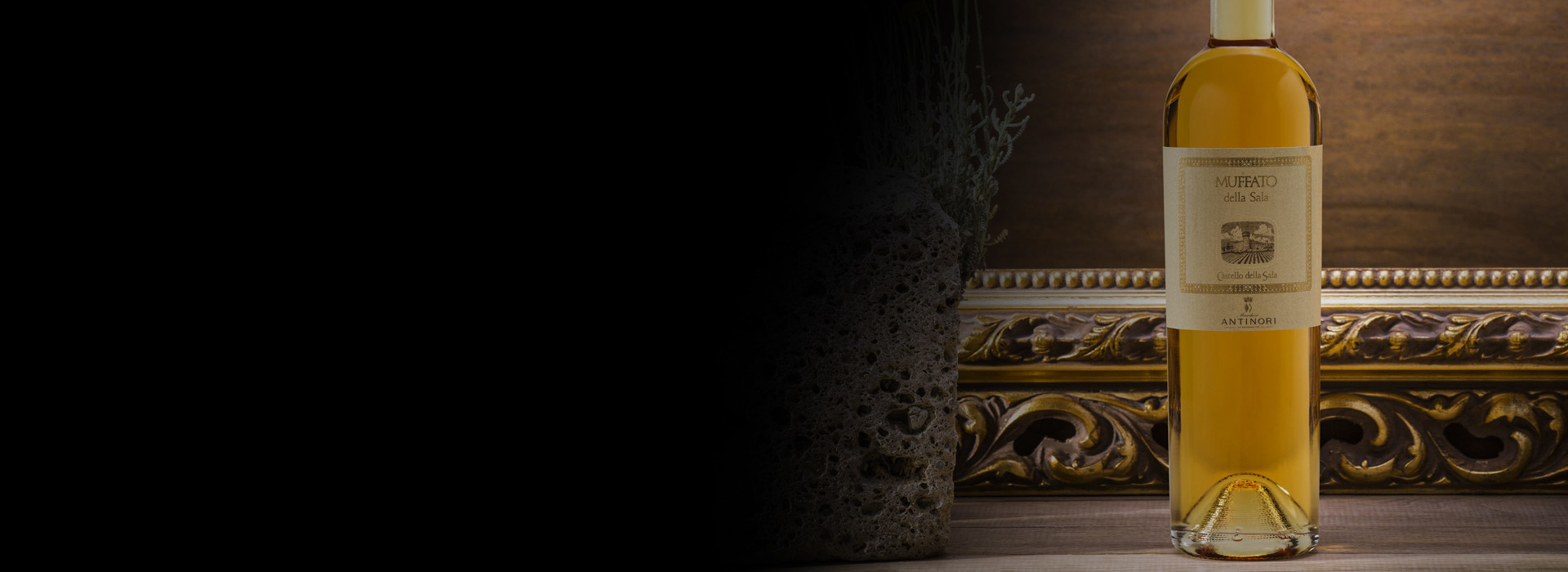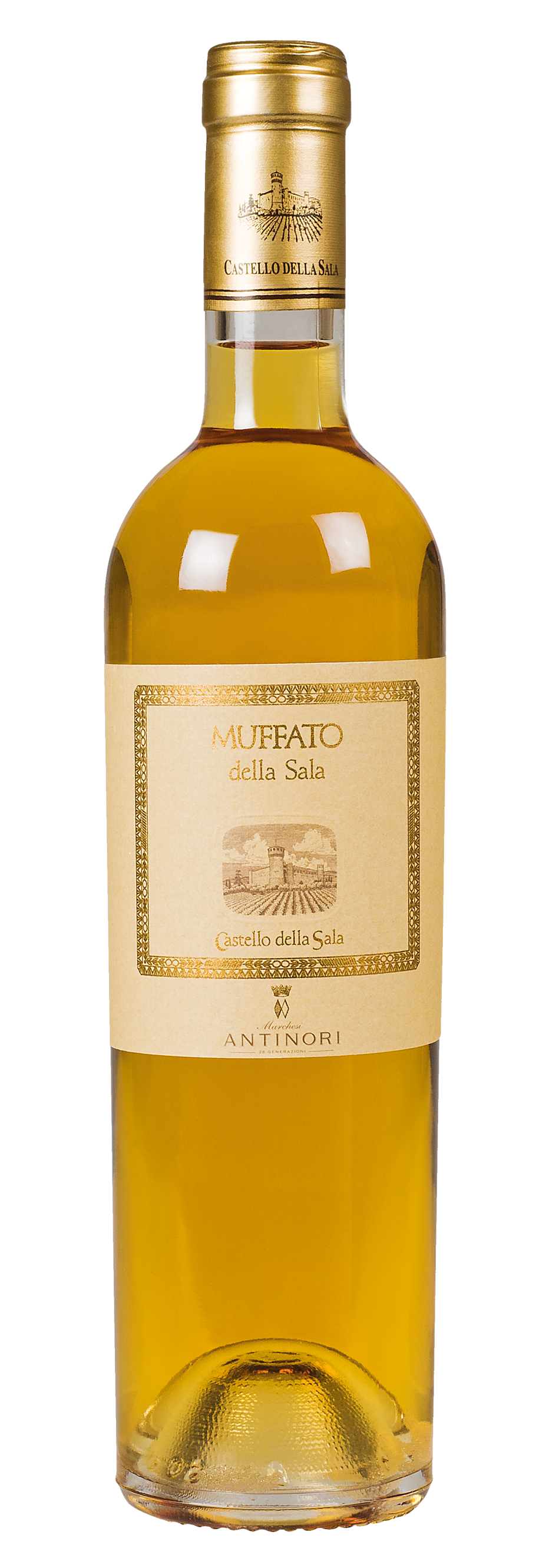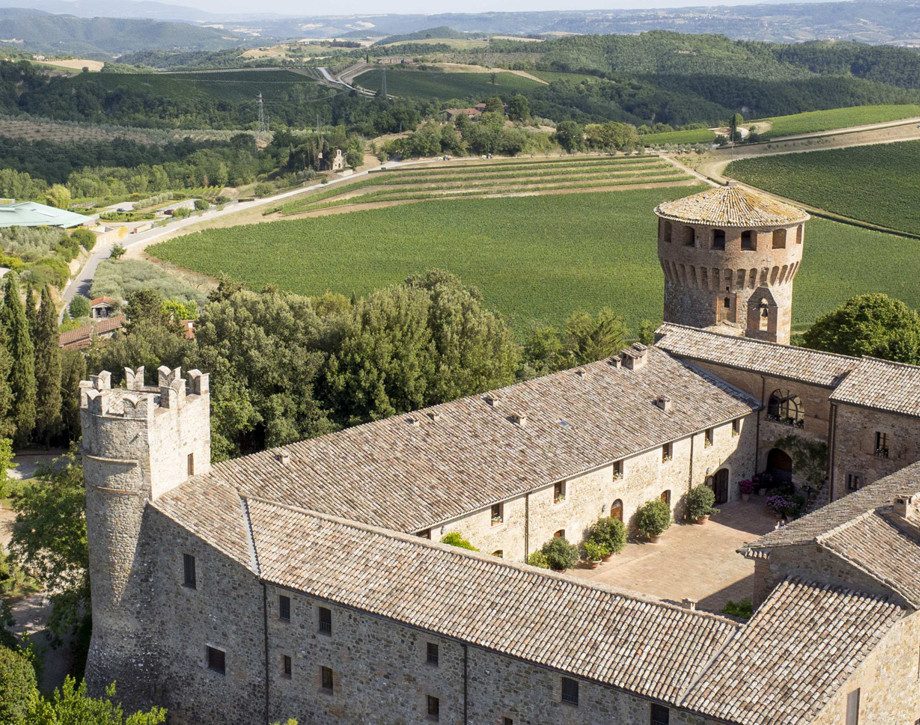Muffato della Sala

Climate
Winter weather brought frequent rain showers and lower temperatures to the area. Springtime wasn’t particularly mild; especially from the end of April to the first half of June, when frequent but light rainfall resulted in early and vigorous vine development. Starting in July, summer turned hot with good temperature fluctuations between day and night. Morning mists and beautiful sunny days during the month of October encouraged the development of Botrytis Cinerea, or noble rot, allowing us to obtain this sweet dessert wine with an interesting aromatic profile. Harvesting activities began mid-October with Traminer and continued with Riesling, Sauvignon Blanc and Sémillon, and were completed at the beginning of November with Grechetto.
Vinification
Grapes were harvested from Castello della Sala’s vineyards, located at an altitude between 200 and 450 meters above sea level (656 and 1476 feet), in clay-based soils rich in marine fossils. All grapes were hand harvested and vineyard crews were sent out to pick individual vineyard parcels or even rows, returning multiple times, depending on the degree of ripeness of the grapes. Once the grapes were delivered to the winery, grape clusters were sorted for quality on conveyor belts. Before being gently crushed, grape clusters were not destemmed. Once the resulting must was pressed, it was fermented for 18 days at a controlled temperature of approximately 17 °C (63 °F). This sweet wine was transferred into French oak barriques (Alliers & Tronçais) where it aged for about 6 months, then continued to age in stainless steel tanks for an additional period of 2 years.
Historical Data
Muffato della Sala is produced with grapes with “noble rot”, harvested in late October and early November to allow the morning mists to develop of Botrytis Cinerea, or noble rot on the grape berries. This type of mould concentrates the water of the crop, its sugars, and its aromas, endowing the Muffato della Sala with a harmonious and unmistakable fragrance. The first year to be produced was the 1987 and consisted of the blend of varieties such as Sauvignon Blanc (50%); Grechetto (30%) and Drupeggio (20%). The composition of the blend has varied over the years and now has attained its definitive results. Muffato della Sala is a fascinating wine, an expression, in small quantities, of the nature of a unique terroir.
Tasting Notes
Muffato della Sala 2016 is an intense, bright golden yellow color. Its nose has depth and complexity with striking citrus aromas that merge with delicate notes of peaches, dried apricots and saffron. The palate is mouth filling, sweet but not too sweet, with light savory sensations and a lengthy finish. Its well-balanced character can be savored immediately, or it can be left to age over time improving its aromatic complexity.

The Wine
This fascinating wine is a blend of Sauvignon Blanc, Grechetto, Traminer, Sémillon and Riesling affected by Botrytis Cinerea (noble rot). The morning mists and local microclimate favour the development of this rot which reduces the water content of the grapes. The resulting concentration of sugars and aromas give the Muffato its special and unmistakeable flavour.

Climate
Winter weather brought frequent rain showers and lower temperatures to the area. Springtime wasn’t particularly mild; especially from the end of April to the first half of June, when frequent but light rainfall resulted in early and vigorous vine development. Starting in July, summer turned hot with good temperature fluctuations between day and night. Morning mists and beautiful sunny days during the month of October encouraged the development of Botrytis Cinerea, or noble rot, allowing us to obtain this sweet dessert wine with an interesting aromatic profile. Harvesting activities began mid-October with Traminer and continued with Riesling, Sauvignon Blanc and Sémillon, and were completed at the beginning of November with Grechetto.
Vinification
Grapes were harvested from Castello della Sala’s vineyards, located at an altitude between 200 and 450 meters above sea level (656 and 1476 feet), in clay-based soils rich in marine fossils. All grapes were hand harvested and vineyard crews were sent out to pick individual vineyard parcels or even rows, returning multiple times, depending on the degree of ripeness of the grapes. Once the grapes were delivered to the winery, grape clusters were sorted for quality on conveyor belts. Before being gently crushed, grape clusters were not destemmed. Once the resulting must was pressed, it was fermented for 18 days at a controlled temperature of approximately 17 °C (63 °F). This sweet wine was transferred into French oak barriques (Alliers & Tronçais) where it aged for about 6 months, then continued to age in stainless steel tanks for an additional period of 2 years.
Historical Data
Muffato della Sala is produced with grapes with “noble rot”, harvested in late October and early November to allow the morning mists to develop of Botrytis Cinerea, or noble rot on the grape berries. This type of mould concentrates the water of the crop, its sugars, and its aromas, endowing the Muffato della Sala with a harmonious and unmistakable fragrance. The first year to be produced was the 1987 and consisted of the blend of varieties such as Sauvignon Blanc (50%); Grechetto (30%) and Drupeggio (20%). The composition of the blend has varied over the years and now has attained its definitive results. Muffato della Sala is a fascinating wine, an expression, in small quantities, of the nature of a unique terroir.
Tasting Notes
Muffato della Sala 2016 is an intense, bright golden yellow color. Its nose has depth and complexity with striking citrus aromas that merge with delicate notes of peaches, dried apricots and saffron. The palate is mouth filling, sweet but not too sweet, with light savory sensations and a lengthy finish. Its well-balanced character can be savored immediately, or it can be left to age over time improving its aromatic complexity.

Castello della Sala
Castello della Sala is located in the Umbria region, not far from the Tuscan border, about 18 kilometers from the historic city of Orvieto. The Medieval castle’s property extends over an area of 600 hectares (1482 acres), 200 hectares (495 acres) are planted with vineyards at an altitude that varies between 220 and 470 meters above sea level (722/1541 feet) on the gently rolling hillsides that characterize the beautiful countryside in this area. Castello della Sala is the perfect place for growing white varieties. The vines grow in clay and calcareous based soils, rich in fossil shells, and they are well exposed to the rising of the sun with an excellent difference of temperature between day and night. The one exception to the rule is Pinot Noir, the only red variety that has found in this area ideal growing conditions to best express its full potential.

Soil
Clay soils rich in deposits of marine fossils.
















